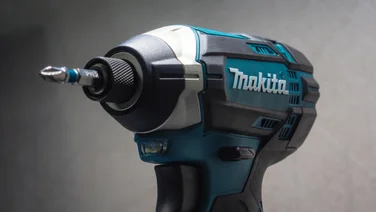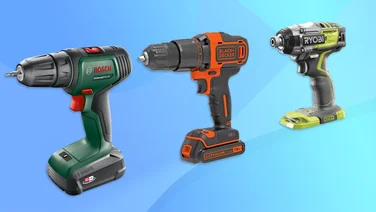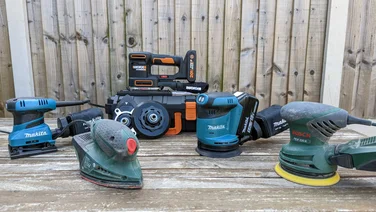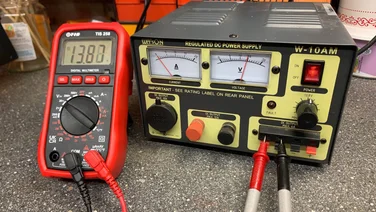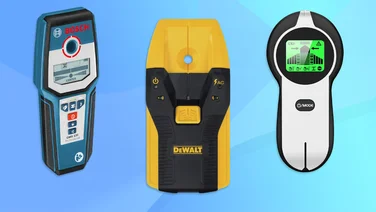To help us provide you with free impartial advice, we may earn a commission if you buy through links on our site. Learn more
- Best orbital sander: At a glance
- How to choose the best orbital sander for you
- How we test orbital sanders
- The best orbital sanders you can buy in 2024
- 1. Makita DBO180Z: Best cordless random orbital sander
- 2. Bosch PEX 220 A: Best-value random orbital sander
- 3. Ryobi RROS18-0: Best-value cordless random orbital sander
- 4. Worx WX822: Best detail orbital sander
- 5. Makita BO3710: Best orbital finishing sander

If you’re going to do a lot of woodwork at home, whether it’s a spot of DIY or crafting things from wood to sell online, a sander is a must-have item in your toolbox. An electric sander is not only going to save you a lot of time, but it can provide you with a much better finish, too.
However, finding the right sander for your workload is no simple task, especially when you can spend either a modest amount of money or a small fortune. There are also plenty of other factors to consider when shopping for a sander.
Beyond brand loyalty and personal preference, you’ll need to decide whether the sander should be corded or cordless; whether you need variable speed; and how much sanding surface you require.
This page will help you navigate the world of orbital sanders. Below, you’ll find our pick of the best orbital sanders to buy, along with a comprehensive buying guide that explains everything you need to know before you take the plunge.
Best orbital sander: At a glance
- Best cordless random orbital sander: Makita DBO180Z
- Best-value random orbital sander: Bosch PEX 220 A
- Best-value cordless random orbital sander: Ryobi RROS18-0
- Best detail orbital sander: Worx WX822
- Best orbital finishing sander: Makita BO3710
How to choose the best orbital sander for you
If you’re new to orbital sanders, there can be a lot of confusing words and specs that often aren’t explained very well on retailer websites.
What is an orbital sander?
Instead of spinning in a complete circle like a vinyl on a turntable, the pad on an orbital sander moves in a small circular motion – much like how you would scrub a dinner plate with a cloth. As it’s such a small orbital motion, to the user it feels like a vibration.Alongside standard orbital sanders, which is what the vast majority of electric sanders for DIY are, you can also buy what are known as random orbital sanders.
These sanders still have the standard orbital motion but add a random element, so as well as the regular orbit, they oscillate in an unpredictable way. The combination of these two movements reduces the chance of a regular pattern in the wood you’re sanding.
Random orbital sanders tend to have a circular sanding pad but orbital sanders can come in many shapes and sizes. If you can only afford to buy one sander, we’d recommend getting a random orbital model.
Not only is there less risk of leaving marks in the wood, they are more versatile and can be used for a wide range of sanding tasks.
Some orbital sanders are very specific in what they are designed to do and as a result, lack the unpredictable motion of random orbital sanders. For example, a detail sander can get into awkward places and is great for very precise tasks.
The other common type of orbital sander that isn’t random is a finishing sander. As the name suggests, these are designed for the final touches rather than tough work such as removing paint (consider a belt sander for that type of job). You’ll want one of these for getting a nice smooth surface either as the final finish or before adding product, such as oil or paint.
READ NEXT: Keep all your gear in one place with the best toolboxes
What else should I look out for?
As you can imagine, sanding makes a lot of dust. Although no sander will suck up all the mess it makes, a decent dust box will at least help with how much cleaning there is to do once you’re finished sanding.
Even better than a built-in dust compartment (if you have a power supply nearby) is the ability to attach the sander to a vacuum cleaner hose. That active suction will reduce the amount of dust a lot in comparison.
Make sure you take a look at the design of the sander before you buy it. Some hardware and DIY stores will have samples available to pick up and hold. Not only do you need to check the weight is okay for you, but also that the way you grip the sander works, especially if you’re not just going to be sanding a flat horizontal surface.
Most sanders are just off or on, but you can find models with variable speed. That might be two or three, but occasionally up to six different settings. Depending on the type of sanding you’re doing, this feature could come in very handy and even save you from sanding a piece of material more than you meant to.
Finally, make sure you’re aware of what size of sanding sheet/pad the sander takes. Most are standard shapes and sizes so it shouldn’t be difficult to find new sheets/pads once the included ones (if there are any) are used up.
Most modern sanders use a hook and loop system, where the sanding sheet attaches to the pad like Velcro. It’s nice and easy but isn’t always as secure as a traditional clamp system, so if you’re concerned about accidents, consider a traditional model.
READ NEXT: Check out our favourite impact drivers
Should I buy corded or cordless?
Of course, one major consideration is whether the sander is wired and plugs into mains power or is cordless and runs from a battery. Neither option is simply better than the other, so it comes down to how and where you’ll be using the sander.
If you’ll be somewhere where mains power isn’t available, perhaps a garden shed, then a cordless sander is clearly the best choice. However, if you’ll be somewhere with a socket and will be doing many hours of sanding and don’t want the hassle of recharging batteries then a corded sander is going to be a lot more suitable.
You might also want to consider whether you already have a battery that might fit a cordless sander. Many brands have interchangeable systems so a battery from your drill might work in a sander if they’re part of the same ecosystem. This is partly why sanders are available to buy without batteries (in other words, body only).
How much do I need to spend?
This is always one of the hardest questions to answer when buying tools. For starters, it depends how much budget you have available in the first place.
You can find orbital sanders for under £50, but they will likely be small, not very powerful and might have a short warranty. We don’t recommend any sanders under £50. Between £50 and £150 is going to be a typical range for DIY sanders depending on whether you need a battery or not.
If you can afford it, buy the right tool for the job you need it to do and you’ll avoid a lot of frustration.
How we test orbital sanders
Here at Expert Reviews, we know that it’s only by getting products physically into our hands and trying them out that we can give you the advice you need when deciding which device to spend your hard-earned cash on. So our experts personally tested all the random orbital sanders you see recommended here, in all available modes, speeds and, where supplied, with all of the attachments.
In order to make things fair, all of the random orbital sanders were tested in the same conditions: outdoors, on a dry day. And, for cordless models, we ensured that the batteries were fully charged. We put them to work on a range of different wood types and on a combination of flat surfaces, edges, and hard-to-reach places. We also used different sandpaper grades to test different stages of sanding. Finally, the ergonomics of each were evaluated, and the key specs – such as dimensions and weight – are listed with each model.
The best orbital sanders you can buy in 2024
1. Makita DBO180Z: Best cordless random orbital sander

Price: £100 or £189 (with battery) | Buy with battery | without now from Amazon
It’s more expensive than many but the Makita DBO180Z is an all-singing, all-dancing random orbital sander that ticks almost every box as long as you’re looking for a cordless model. It’s available with or without the battery.
Not only is the DBO180Z lightweight, but it also has three speed settings to cycle through by hitting the power button repeatedly. This makes it very versatile and a good option for beginners who can start at the slowest speed while learning.
The maximum speed isn’t overly impressive but performance is good enough for the vast majority of DIY tasks and there’s a built-in dust bag which does a good job. This sander also works nice and quietly. The main gripe here is with the grip, which gets in the way of accessing the battery compartment a little bit.
Key specs – Weight: 1.7kg; Maximum speed: 11,000 orbits/min; Pad diameter: 125mm; Orbit diameter: 2.8mm; Lock-on switch: Yes; Variable speed: Yes, 3 speeds; Dust box: Yes; Power rating: 190W
2. Bosch PEX 220 A: Best-value random orbital sander
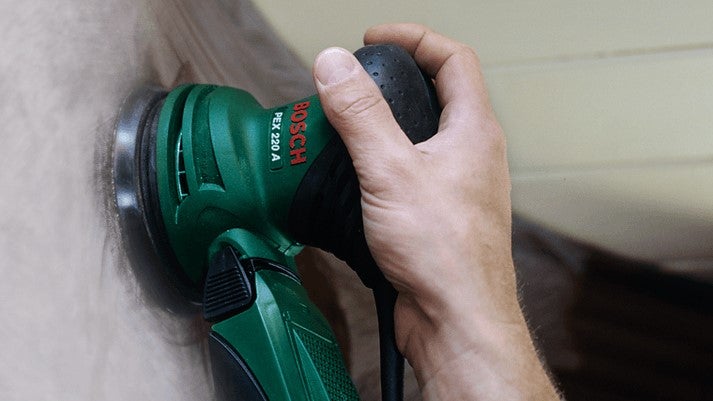
Price: £62 | Buy now from Amazon
Those looking for a no-nonsense, corded random orbital sander without breaking the bank should try the PEX 220 A from Bosch. It’s an excellent-value option that will happily get to work on a range of different sanding tasks from stairs to sculptures.
If you don’t need features like variable speed then the PEX 220 A is a good choice. Slap a sanding sheet on with the Velcro-style system, plug it in and away you go. The toggle switch will keep you going as long as you need and there’s plenty of power available.
Partly as there’s no need for a battery, the PEX 220 A is very light, meaning you can use it for a long time and at awkward angles without fatigue. The dust box is easy to empty but the clip system holding it to the sander is on the loose side.
Key specs – Weight: 1.2kg; Maximum speed: 24,000 orbits/min; Pad diameter: 125mm; Orbit diameter: 2.5mm; Lock-on switch: Yes; Variable speed: No; Dust box: Yes; Power rating: 220W
3. Ryobi RROS18-0: Best-value cordless random orbital sander

Price: £75 (without battery) | Buy now from Ryobi
Ryobi’s new cordless random orbital sander is an excellent value choice, especially if you already have other products from the ONE+ range, as you can share the battery. Plus, there’s a long three-year warranty.
It doesn’t have variable speed but the RROS18-0 runs at an impressive 20,000 orbits/min, can last for up to 50 minutes on a single charge and runs quietly. Despite being more compact and lighter than its predecessor (10% according to Ryobi), it is a little heavier than some rivals.
The weight isn’t enough to factor too much and importantly, the battery doesn’t impede when gripping the sander. The active dust extraction is very good – aided by a skirt around the sanding pad – but you can attach this sander to a vacuum hose, too.
Key specs – Weight: 2kg; Maximum speed: 20,000 orbits/min; Pad diameter: 125mm; Orbit diameter: 2.5mm; Lock-on switch: Yes; Variable speed: No; Dust box: Yes; Power rating: Not specified
4. Worx WX822: Best detail orbital sander

Price: £65 or £120 (with battery) | Buy with battery | without now from Amazon
It might seem a little expensive compared to a lot of detail sanders on the market, but the Worx WX822 is a two-in-one design. As well as being a traditional triangle shape for the main sanding pad, there’s also a finger sander add-on which quickly screws into place with a single screw.
It’s very lightweight and easy to use, with different ways to grip it. It’s not massively powerful and only has one speed but these are normal attributes and it does what it’s supposed to do very well.
Worx handily supplies the sander in a hard plastic carry case if you buy it with a battery and you get a decent amount of sanding sheets included, too. On the downside, the dust bag is small and doesn’t offer very good suction.
Key specs – Weight: 1.2kg; Maximum speed: 12,000 orbits/min; Pad diameter: Various; Orbit diameter: 2mm; Lock-on switch: Yes; Variable speed: No; Dust box: Yes; Power rating: 40W
5. Makita BO3710: Best orbital finishing sander

Price: £69 | Buy now from Powertool World
If you’ve got large flat areas to sand and they aren’t covered in layers of paint that need removing then the BO3710 is an excellent choice.
The sander is bigger than a lot of finishing sanders (aka palm sanders) so will make much quicker work of things like doors and floors. The BO3710 takes ⅓-sized sheets of regular sandpaper – which attach via a rubberised clamping lever system and punch hole – meaning you can save a lot of money on sandpaper compared to hook and loop.
Despite its size, the sander is lightweight and can easily be used with two hands thanks to the grip design. There’s also a two-finger power button which can be locked on. The dust bag is large and unzips for easy emptying.
Key specs – Weight: 1.6kg; Maximum speed: 11,000 orbits/min; Pad size: 92x185mm; Orbit diameter: Unknown; Lock-on switch: Yes; Variable speed: No; Dust box: Yes; Power rating: 190W







